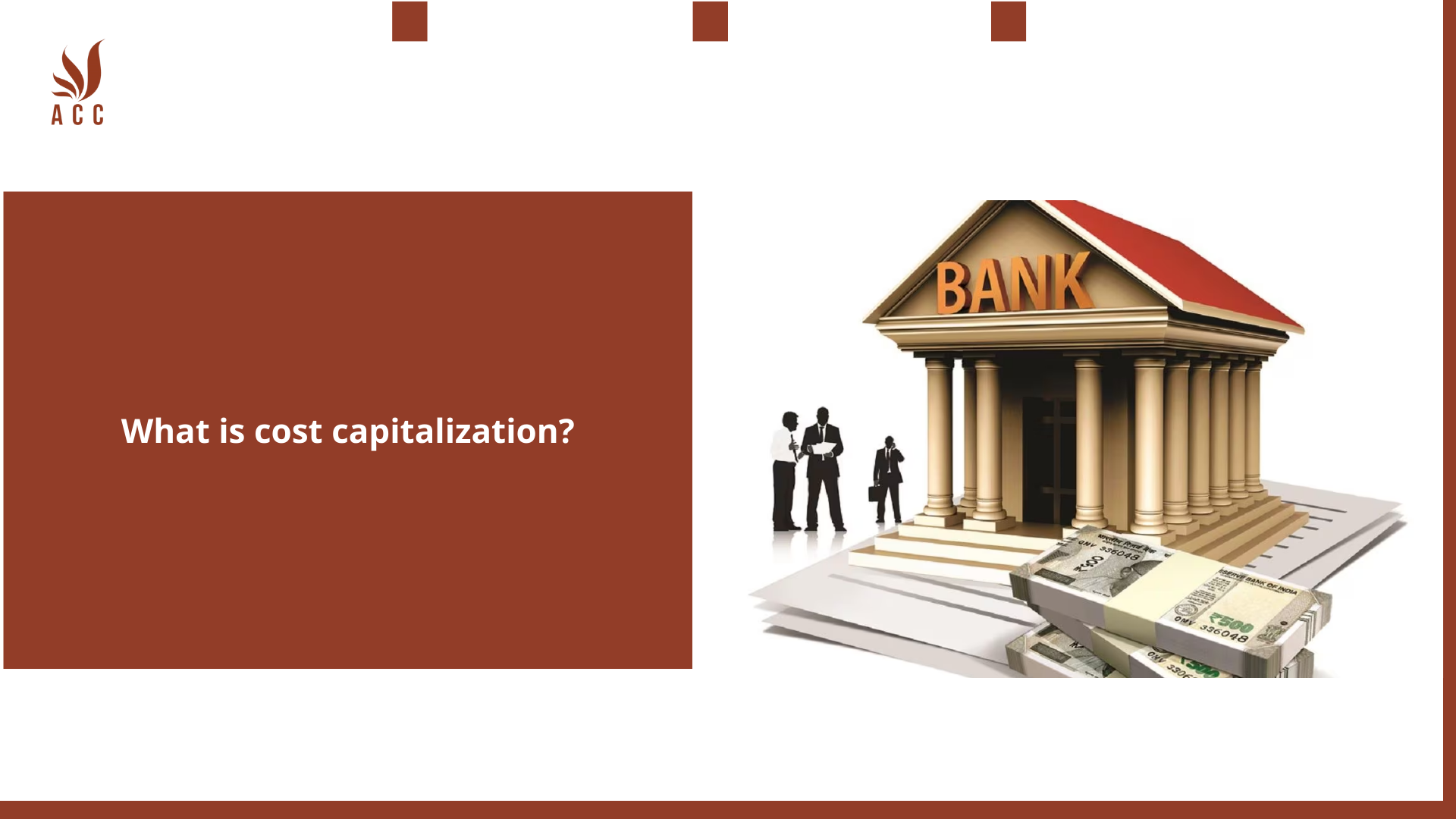
1. What is cost capitalization?
In the world of finance and accounting, understanding the concept of capitalized costs is crucial for businesses. These costs play a pivotal role in determining how companies manage their financial statements and assets. In this article, we'll delve into the intricacies of capitalized costs, shedding light on their significance and impact on a company's financial health.
2. Demystifying Capitalized Costs
A capitalized cost is an expenditure that is added to the cost basis of a fixed asset on a company's balance sheet. These costs are typically incurred when a company is either constructing or acquiring fixed assets. Unlike regular expenses, capitalized costs aren't recognized immediately in the period they were incurred. Instead, they are spread out and recognized over time through processes such as depreciation or amortization.
3. Key Insights into Capitalized Costs
Here are some key takeaways to help you grasp the essence of capitalized costs:
Preserving Monetary Value
With capitalized costs, the money spent doesn't leave the company's coffers when purchasing an item. Instead, it is retained in the form of a fixed or intangible asset.
Depreciation and Amortization
Capitalized costs undergo depreciation or amortization over time, unlike regular expenses that are immediately deducted.
ligning Costs with Revenue
The primary objective of capitalizing costs is to ensure that the expense of using an asset aligns with the duration during which the asset generates revenue.
Threshold for Capitalization
Each company establishes a dollar value threshold that distinguishes an expense from a capitalizable cost.
Special Cases
In certain situations, employee salaries and bonuses can also be capitalized, depending on the circumstances.
4. The Rationale Behind Capitalized Costs
When a company decides to capitalize costs, it adheres to the matching principle of accounting. This principle emphasizes recording expenses in the same period as the corresponding revenues. In essence, it aims to synchronize the cost of an asset with the periods in which the asset is in use and, consequently, generating revenue.
5. Capitalizing Long-Term Assets
Long-term assets continuously generate revenue throughout their useful life. Therefore, their costs can be depreciated or amortized over an extended period. According to the Internal Revenue Service, various business assets, including land, buildings, machinery, and even patents, need to have their costs fully capitalized.
For instance, during the construction of a warehouse, the costs associated with building it, such as labor expenses and financing costs, are added to the carrying value of the fixed asset on the balance sheet. These capitalized costs are subsequently expensed through depreciation in future periods, coinciding with the recognition of revenues from the factory's output.
6. Software Development as a Capitalized Cost
Software development is another intriguing example. Among the three phases of software development—preliminary project stage, application development stage, and post-implementation/operation stage—only costs from the application development stage should be capitalized.
These costs may encompass employee salaries, bonuses, debt insurance, and data conversion expenses. However, they are capitalizable only if the project requires additional testing before application.
7. Real-World Example of Capitalized Costs
To illustrate the concept further, consider a coffee roasting facility. Building and operating this facility involve various costs, including customizing it for specific business needs, acquiring roasting and packing equipment, and installation expenses. The company also has to purchase green coffee, pay employees for roasting and selling coffee, and cover marketing, advertising, sales, and distribution costs.
Items such as utilities, pest control, and employee wages fall under regular expenses as their value is directly linked to a specific accounting period. On the other hand, items like a $200 laminator or a $50 chair are considered expenses due to their relatively low cost, despite being used over multiple periods. Each company sets its threshold for distinguishing expenses from capitalizable costs based on their dollar value.
In contrast, the packaging machine, roaster, and floor scales in the coffee roasting facility are considered capitalized costs. Their monetary value remains within the company, even after purchase. For instance, when the company invests $40,000 in a coffee roaster, the value is retained as a company asset. The expenses related to shipping and equipment installation are also included as capitalized costs, as they are essential for setting up the building for its intended use.
8. The Lifecycle of Capitalized Costs
Initially, capitalized costs are recorded on the balance sheet as assets at their historical cost. Over time, they move from the balance sheet to the income statement, where they are expensed through depreciation or amortization. For example, a $40,000 coffee roaster may have a useful life of seven years with a $5,000 salvage value at the end of that period. In this case, the annual depreciation expense for the coffee roaster would be $5,000 [($40,000 historical cost - $5,000 salvage value) / 7 years].
9. Pros and Cons of Capitalized Costs
Understanding when to capitalize costs is essential for maintaining financial transparency. Here are the advantages and disadvantages of capitalizing costs:
Advantages:
-
Cash Flow Management: Capitalizing costs can help free up cash flow, allowing expenses to be spread across multiple quarters.
-
Smoothening Expenses: Capitalization prevents large spikes in expenses in a single year, providing a more consistent financial picture.
Disadvantages:
-
Misleading Profit Margins: Inappropriate capitalization can mislead investors about a company's profit margins.
-
Reduced Free Cash Flow: Capitalizing costs can lead to drops in free cash flow.
-
Higher Taxes: Initially, capitalization can result in higher tax bills for the company.
10. What Can Be Capitalized?
A wide range of expenses can be capitalized, including intangible assets like patents and software creation. Additionally, costs related to transportation, labor, sales taxes, and materials may also be capitalized.
In conclusion, understanding capitalized costs is vital for maintaining financial accuracy and transparency. It ensures that companies align their expenses with their revenue, ultimately leading to more informed financial decisions and enhanced accountability.
11. Why should professionals use ACC Law Firm's capital Service?
-
Expertise in Legal Matters: ACC Law Firm specializes in legal services, providing professionals with access to experienced attorneys who can offer valuable legal guidance. Whether it's contract negotiations, intellectual property issues, employment matters, or any other legal concern, their expertise can be invaluable.
-
Tailored Legal Solutions: ACC Law Firm understands that every professional's needs are unique. They can customize their legal services to address the specific challenges and opportunities faced by professionals in different fields.
-
Risk Mitigation: Legal issues can pose significant risks to professionals and their businesses. ACC Law Firm can help identify and mitigate these risks, reducing the potential for costly legal disputes or compliance issues.
-
Resource Optimization: Professionals can save time and resources by outsourcing their legal needs to ACC Law Firm. This allows them to focus on their core competencies and business objectives, while leaving legal matters in the hands of professionals.
-
Access to a Network: ACC Law Firm may have a network of legal experts and professionals in various fields, which can be beneficial for clients seeking connections and advice beyond just legal services.
Q&A
Question 1: When should you capitalize the first letter of a sentence?
Answer 1: The first letter of a sentence should be capitalized. It's a fundamental rule in English writing to begin a new sentence with a capital letter.
Question 2: Should job titles always be capitalized?
Answer 2: Job titles are capitalized when they are used as a part of someone's name, such as "Doctor Smith" or "President Johnson." However, when used generically, such as "the president of the company," they are not capitalized.
Question 3: Do I need to capitalize the names of the days of the week and months?
Answer 3: Yes, the names of the days of the week and months are capitalized in English. For example, "Monday" and "June" should always be capitalized.
Question 4: Is it necessary to capitalize the first letter of proper nouns?
Answer 4: Yes, proper nouns, which are specific names of people, places, or things, should always have their first letters capitalized. For example, "John," "Paris," and "Microsoft" are all proper nouns and should be capitalized.
Nội dung bài viết:






Bình luận